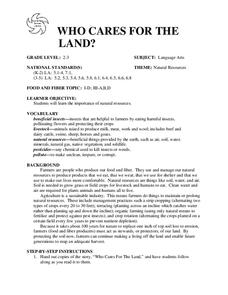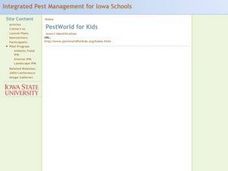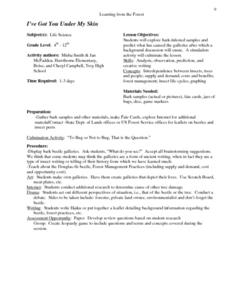Curated OER
Invasive Plants
Pupils identify dandelion plants and label the areas where they are growing on a school site map. They identify other weeds in the area and determine whether or not they are crowding other plants native to the area. They label these...
Curated OER
Discovering Insects
First graders will gain a better understanding about insects.They then will be able to identify insects as well as be able to learn the names of the nine most commonly known insects.
Curated OER
Is that Tree Safe?
Students examine the parts of the tree and examine the health of trees in the vicinity. In this tree safety lesson students work in groups to complete a stated goal.
Curated OER
Selecting Trees for Urban Environments
Students consider the best place to plant a tree. In this environment lesson, students identify urban locations that are compatible with particular tree types. Students decide what trees would go where and why they would survive.
Curated OER
Let's Create an Ecosystem
Seventh graders discover how an ecosystem works by creating one in class. In this Earth science lesson, 7th graders study vocabulary terms associated with ecosystem and read environment handouts. Students create an observatory...
Curated OER
Wild Dog Debate
Students participate in a mock conference addressing the possible extinction of African wild dogs. In this wild dogs lesson plan, students state their arguments and ask questions about the issues they have researched.
Curated OER
What's Organic?
Young scholars discuss background information presented by the teacher and read dictionary definitions for the words "organic" and "synthetic." In this gardengin lesson, students complete a worksheet on the material. Young scholars grow...
Curated OER
Backyard Habitats
Young scholars identify habitat elements. They create a habitat in a backyard, on a balcony, at a workplace, or in a schoolyard and provide the four basic requirements of wildlife survival (food, water, cover, and places to raise young)....
Curated OER
WHO CARES FOR THE LAND?
Students explore the importance of natural resources. They are given copies of the story, "Who Cares For The Land," and students follow
along as the teacher reads it. Students identify the key points in the story. (Soil, water and air...
Curated OER
Environment: Mealworm Observations
Students observe plant and animal growth and participate in class discussions about the subjects. They also record their observations in a log. Using observation and the scientific method, they describe the characteristics of mealworms.
Curated OER
How Much Is an Ecosystem Worth?
Students examine the value of ecosystems. They read and analyze an article, evaluate ecosystem services, research the benefits of biomonitors, and design a public service announcement.
Curated OER
What Makes Up an Ecosystem?
Eighth graders develop a model of an ecosystem in a cooperative learning group
Curated OER
Beautiful Butterflies -- Activity Centers
Sixth graders observe and describe habitats within ecosystems, describe how organisms modify environment to meet their needs, and observe and identify characteristics that allow survival.
Curated OER
Pesticide Use: Environmental Awareness and Impact of Conservation Organizations
Eleventh graders examine the history of public concerns associated with pesticide use, and identify conservation organizations that examine pesticide use. They write reports to evaluate conservation organizations.
Curated OER
Let's Create an Ecosystem
Seventh graders are introduced to the concept of ecosystems by allowing student to create their own ecosystem in a jar.
Curated OER
Habitat Breakdown
Fourth graders examine how insects and organisms are impacted by factors that are essential to an organism's survival in particular habitats. They participate in a habitat game in which they imagine themselves as insects.
Curated OER
Discovering Insects
First graders identify insects and name nine commonly known insects.
Curated OER
Little Me in a Big World: Ants
Pupils use the life cycle of an ant to learn about their own self-esteem. In this self-esteem lesson plan, students read books about ants and discuss obstacles from the stories as well as the ant behavior.
Curated OER
I've Got You Under My Skin
Learners examine bark beetle galleries, discuss interdependence between insects, trees, and people, and research to determine causes of other tree damage.
Curated OER
What's Organic?
Students define and discuss terms organic and synthetic, read article pertaining to organic agricultural practices in Oklahoma, complete worksheet, grow plants using both commercial and organic fertilizer, compare growth rates, and chart...
Curated OER
Natural Gardening
Students study the effect of pesticides on plants and insects. In this gardening instructional activity, students discuss the importance of insects. They define pesticides, evaluate their effectiveness and the problems they might...
Curated OER
Mussel Movements
Young scholars consider the impact of invasive species on local environments. In this ecology lesson plan, watch the video, Arizona Wildlife Views, which focuses on invasive species. Students develop vocabulary, relate to meaningful...
Curated OER
Web of Life - Ecosystem
Third graders play the roles of various organisms in an ecosystem (focusing on insects) and pass yarn or string around to other organisms from largest animals to the smallest. The end product is a web which shows how all of these animals...
Other popular searches
- Integrated Pest Management
- Pest Management Products
- Pest Management Information
- Intergrated Pest Management
- Inter Grated Pest Management
























